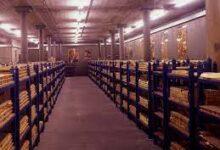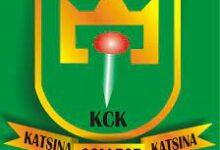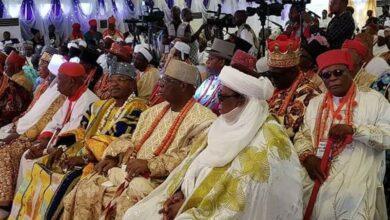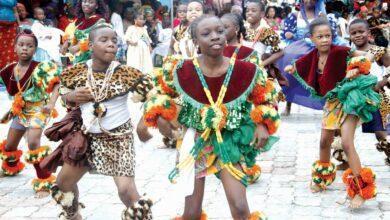
Awon Mass Wedding Festival is a festival that takes place in Shao in Moro Local Government of Kwara State, Nigeria. It is a festival during which all the young girls of marriageable age in Shao are given out in marriage all at once.
This festival is a colorful dance and folksongs festivals where a lot of colorful attires are put on display. The people of Shao are also hospitable people and they cook massively during the festival for all who come to celebrate with them.
👉 Relocate to Canada Today!
Live, Study and Work in Canada. No Payment is Required! Hurry Now click here to Apply >> Immigrate to CanadaSons of the soil in Shao and all over the world always come around during Awon mass wedding festival to join in the celebrations.
Historical Background of Awon Mass Wedding Festival
Accoding to the history of Shao, there was a hunter called Omo Larele who would stop at a small stream to drink water anytime he went hunting in the forest.
As was his tradition, he stopped by the stream to drink water on a particular day and he saw a strange woman at the stream seated there already, this woman was weird looking as she had only one breast.
History tells us that the woman was a fairy and her name was Awon. She told the hunter that she was the owner of the stream which he normally drank from.
She told him she wasn’t angry at him but that Omo Larele should take her to the Oba of Shao, Oba Olanibo who was the first Ohoro of Shao. Awon was taken to Shao and she spent eighteen days with the people of Shao. Before she left, she had a meeting with Oba Lanibo and the royal chiefs.
When she was set to depart from Awon, she was accompanied by Oba Lanibo, his son and the royal chiefs of Shao and they followed a path that Awon chose.
After walking for some time, she stopped and told all the people that her name was Awon. She then told the people that they would never see her again, but that she would fortify their community by giving them a strong charm and that they should rename the village Shao-Awon.
👉 Relocate to Canada Today!
Live, Study and Work in Canada. No Payment is Required! Hurry Now click here to Apply >> Immigrate to CanadaIn addition to this, she told the Oba of Shao that a day should be set aside every year to celebrate Awon and on this a mass wedding ceremony should be held where all girls of marriageable age should be given out in marriage.
She further told them that she would give them blessings at any time they request for it and especially on the day Awon is celebrated.
She said they should channel through a priest that would be dedicated to her problems of barrenness and ill fortune so that she could turn their fortunes around for them.
After this speech, Awon fell down and disappeared, immediately waves appeared at the spot of her disappearance and water began to gush out from there.
The water started to flow and it became a big river called Awon River and the spot was named “Awon Yale”, meaning Awon visits home.
This spot is significant among the people of Shao and it is referred to as “Ojubo Awon”, this means the spot where people gather to worship the goddess Awon.
After this event, the Oba of Shao received two visitors again; they were women who claimed they were Awon’s sisters and were looking for her.
The women were now told that though Awon visited them at Shao, she had vanished into thin air. The women searched for a while but when the search did not yield any result, they left for an unknown destination.
Later, the people got to know that the sisters also became rivers, one of them known as Asa is the Asa River which runs through Ilorin and the other sister known as Osun is believed to be the Osun River in Oshogbo. Today, figurines with the same similarities are found in the shrines of both Osun and Awon buttressing the fact that they might be related.
After Awon and her sisters left, Oba Lanibo, the Ohoro of Shao and his chiefs told Mogaji Gbenagbena, the head of wood carvers to make a wooden image of the one breasted Awon and that of her sisters so as to immortalize them and have a symbol of their presence in Shao.
He then made a decree that the Awon mass wedding festival be held every year in Shao in remembrance of Awon and her sisters.
A family was also chosen as the custodian of the images and also to watch over the spot where Awon disappeared. This family is now known as “Ile Alawon”, this means the custodian of Awon.
A particular person in the house is then chosen to make rituals and sacrifices to Awon Goddess, this person is the priest of Awon, called “Baba Alawon”. Anybody chosen as the priest of Awon is forbidden from crossing rivers.
The Awon Mass Wedding Celebration
After all the marriage steps have been concluded between a young man and woman and the parents have accepted that they can get married.
The fixing of the date of the wedding will follow. The date fixing involves a lot of participants, the Awon priest being the most important person.
The other people involved in the date fixing are the Iboo, the Ajankii and the traditional/religious leaders in Shao community.
Everyone will gather at the Alawon compound which houses the Awon Shrine. When Awon accepts the day fixed for the marriage, the women in Awon compound will start celebrating by singing and dancing round the town and jingling a bell called the Agogo Awon.
This ringing of this bell is to inform the whole community that the day for the Awon mass wedding has been fixed. Food is then prepared for the people that came to witness the date fixing.
After the announcement has been made, parents of the couples will start preparations in earnest for the wedding. They will make provision for food and drinks for guests; they will also have to buy clothes for their sons and daughters.
The bride’s parent has to buy her the items she will use in her husband’s house. These items include plates, cups, spoons, pots, mats and other cooking utensils.
The parents will also send invitations for the wedding to their people to let them know the date that has been chosen for the Awon mass wedding.
On the day of the Awon mass wedding, there is a lot of cooking is done by the parents of the bride and groom and well-wishers also help them out.
There is a lot of dancing during the festival. In the past, after the marriage ceremony, the bride, their relatives and friends will clap and sing and go to the shrine of Awon to pray for a successful marriage.
This is no longer in practice because of the influence of religion, what they do now is to go to their church or their mosque to pray and do thanksgiving for the marriage.
Awon Festival
The Awon dance festival takes place two months after the mass wedding and every woman in Shao must take part in the dance.
On this day, every woman must stay at home to make bean cakes for Awon. Any woman that flounts this order and goes out will be chased back home by a masquerade caleed “Duo Dika”.
The dance commences in the afternoon with the women assembling in front of the Baba Alawon’s house. Drummers are also present to play at the event.
There is a lot of singing and dancing during the festival. At a time, the dancing becomes so rigorous and the masquerade makes an appearance again.
The masquerade proceeds to chasing the women out of the dance arena and they run to their various homes. The festival day usually ends at about 6 o’ clock in the evening.
The Awon Festival is one that the people of Shao look forward to with anticipation every year.
Hope you love the feature today.







